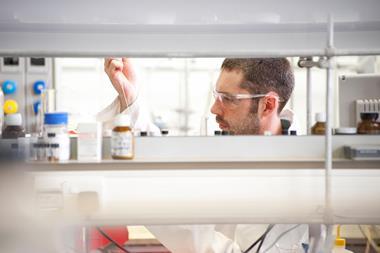Data management systems are widely used in certain sectors of industry, but how do different systems compare? Anthony King finds out

Laboratory information management systems (LIMS) are lab workhorses, carrying the major burden of managing information by assisting in its production, collation and reporting. And as lab analytics and processes have become ever more complicated, this has been matched by more and more sophisticated LIMS.
At the same time, electronic lab notebooks (ELNs; see Notebooks go digitial) have emerged over the last few years to challenge the traditional LIMS products. While ELNs are better with mostly unstructured, document- and experiment-centred data, LIMS have been the beefier stablemate particularly suited to sample-centric and more structured data.
LIMS have been around for a long time, says consultant John Trigg at phaseFour Informatics. ‘Originally, they were very much focused on sample and test management systems, so organising work in terms of registering samples, gathering test results and issuing reports.’ Over time, their scope and capabilities inevitably extended and specialised in specific types of labs, with some LIMS more geared toward quality assurance operations, some tied strongly with regulatory compliance and others supporting industry-specific workflows.
Without doubt, says Trigg, LIMS are at their most powerful in routine environments where you may be running batch mode operations, where you are trying to replicate user systems to address specific work flows and getting high throughput. ‘That doesn’t match so well with academic labs so it never surprises me that LIMS is not a big player in academia,’ he notes. ELNs may be more suited to free-wheeling academia, but open-source LIMS software can be strong too and labs often write their own.
LIMS or ELN?
Choosing a LIMS product is no simple task. To confuse matters, over the years there has been a great deal of convergence between LIMS, ELNs and scientific data management systems, to the point where it can be hard to distinguish between some of them. ‘LIMS haven’t adapted well to the needs of the research community, which is the main reason you see all these ELN systems,’ says consultant Michael Elliott at Atrium Research. ‘Now you have companies working to add LIMS functionality, such as sample tracking, to ELN systems.’

Ten years ago, the LIMS and ELN markets were completely separate, whereas over the last few years LIMS companies have begun to offer an integrated ELN and the dividing line has become hazy. John Jones, chief executive of LabLynx and founder of the trade association Laboratory Informatics Institute, says LIMS remain the big dogs in the park. ‘LIMS’ is a much more precise term, he argues, whereas ‘ELN’ is vaguer – lab books in electronic form really. ‘LIMS will eventually absorb ELNs,’ he predicts.
LIMS have been around since the 1980s and are mature products; many can serve all sorts of lab environments and commercial systems can be incredibly complex to deploy. But some are looking now to have simpler systems, argues Elliott, particularly in R&D. ‘Give me that app or that simple side view so I don’t have to concern myself with complexity. That’s a tough challenge,’ says Elliott. Some products display more web and mobile compatibility than others, but Elliott says all the major LIMS players produce products of comparable capabilities.
Heavy hitters
There will be some consistencies between certain types of operations in different labs, but every organisation will also have its own idiosyncrasies and quirks. For this reason, Trigg says it is unusual for a lab to look at a commercial organisation and decide that it fits and does everything they need. This raises questions about the adaptability of various products and whether they can be configured or customised to match the full set of user requirements. Configuration rather than customisation is the preferred way to address any missing functionality, as customisation implies writing code that might cause problems with future LIMS product updates.

‘One of the strongest points about our web-based LIMS is its flexibility and configurability. We can adapt to changing business needs post-implementation. Over the years, hundreds of labs across industries have implemented our system,’ says Puneet Goel, director of product management and marketing at LabVantage. This LIMS vendor also offers some pre-packaged solutions in the areas of pharmaceuticals, quality management and biobanking. The company’s last release was in December when it added significant new capabilities. ‘Some of our competitors haven’t refreshed their product in a long time,’ adds Goel.
LabVantage is one of the four heavy hitters in the traditional LIMS market. The other three are LabWare, STARLIMS and Thermo Scientific. Experts say it can be hard to put clear daylight between them.
‘Differentiation between core capabilities isn’t that great,’ says Elliott, who says the big four probably have 60–70% of the commercial market, a figure disputed by others. Differentiation comes from approaches to how those capabilities are addressed, user experience and consulting service. They all offer a fairly comprehensive product across most of the analytical chemistry sector, Trigg adds. Most make their product configurable and some are modular. So rather than purchasing one titanic system, you buy the modules you need, which tends to rein in the price a bit.
Nick Townsend at LabWare says his company offers a LIMS and an ELN as part of its enterprise lab platform, which includes a library of modules that can be used for different types of applications, such as document management, stock control or instrument management. This library has been built up over 20 years. ‘We have doggedly kept to a single product for good reasons, but tackled specific industries by developing specific modules,’ Townsend explains.
Regulation is forcing companies to operate more like those in the food, beverage or pharma industries, according to Goel of LabVantage, meaning more need to use LIMS. Supplement manufacturers and tobacco companies are among these firms. ‘There is also an entire industry emerging in biobanking, where long-term storage of specimens is done for clinical and research purposes. We are seeing a lot of new demand there,’ he says. As an example, he points out Duke Biobank, based in the Duke University Translational Medicine Institute in Durham, US, which took on a LabVantage system to manage sample inventories.
Small, but legion
LabLynx offers a product ‘that adapts to different customer’s needs as it is highly configurable’ and counts high-throughput screening labs, oil refineries and medical labs as customers. ‘No industry makes up more than 7% of our customer base,’ says Jones. He is involved with a LIMS forum on professional networking website LinkedIn that has over 56,000 members and hosts lively discussions on all things LIMS.

Jones says the LIMS market is not dominated by four players. There are over 150 vendors on the market, not including freeware or bespoke software written by users or consultants. Jones says commentators too often have a narrow definition of LIMS and exclude LIS, laboratory information systems, which classically tended to be applied to lab informatics systems for clinical markets. He thinks the LIMS market is in the multibillion dollar bracket, pointing to the $1.4 billion (£860 million) purchase of Sunquest, the medical software developer in Arizona, by Roper Industries in 2012.
‘People come out with these niche solutions and they sell them out of their garage. If I’m a niche software developer, with three or four staff, and I sell a couple of million dollars’ worth [of LIMS] a year I can make a pretty good living,’ says Elliott. He remains surprised that small labs tend to go for the small companies, even though they may be taking a big risk. ‘In 1984, I never thought that the LIMS market would support more than three or four players; that was the only major market prediction I got so wrong. I wouldn’t have imagined in my wildest dreams that the market could support all those little people.’ He puts this down to underestimating people’s ability to look past the economic and infrastructure issues and say ‘This product looks neat, it does what I want it to do, I’m going to buy it.’
‘This market also tends to work a lot by herd mentality,’ says Elliott. ‘Organisations are inclined to invest in a technology because their competitors or others they know have experience of it.’ The specificity of applications to niche requirements is also a major motivating factor. The more the system does what users need it to do out of the box without exhaustive configuration, the easier it is to justify.
Trigg views the multitude of players in the market as organic growth from do-it-yourself operations that initially developed a system for themselves or a client. He says it is tough for those guys to provide the support required. Nonetheless, there are a number of speciality providers that are big and reliable enough in their realm. Baytek headquartered in Houston, Texas, has experience in the refinery LIMS industry; JusticeTrax in Arizona serves forensics science labs; Wavefront Software in Ohio have been specialists in metal manufacturing; while Kenny Agrisoft in Ireland serves the argicultural sector with its DairyLIMS.
Academia uninterested
Commercial LIMS have largely failed to breach academia’s walls. Townsend at LabWare says they don’t supply many systems to academia, except in a few instances, for example where regulatory compliance is an issue.
‘Academics write a lot of custom-built LIMS,’ says Elliott. There is logic to this, according to Trigg, who says it never surprises him that take-up is low: ‘In most cases the vendor systems are overkill. They just have way too much stuff than an academic lab needs.’
The time is coming when people will have to make their data available for others
John Jones says LabLynx has no plans to sell to academics. ‘Their work is so wildly varied that they don’t fit into a production environment. And their money is for doing research, not buying software. They can take their free students and have them build what is needed for a project and it is all part of the educational process. Open source and academia go just beautifully together,’ says Jones.
Not everyone agrees though. ‘Academia is one of our fastest growing segments and where we have seen most growth is in biobanking,’ says Goel of LabVantage. ‘These are academic and research institutions, often with research hospitals, which are storing specimens.’ A good system reduces costs and helps with collaboration, he says.
Tim Dickens, head of IT at the chemistry department in Cambridge University, blames ‘conservatism’ in academia for a lack of up-take. ‘There isn’t the same pressure or effort put into curating and managing data that you get in a commercial environment,’ he says. ‘It will only change when journals or granting authorities make clear it is not sufficient just to publish scientific papers, but to also publish raw experimental results. But that time is coming when people will have to make their data available for others to analyse.’ One of the big benefits of LIMS in industry is that it allows sharing of data across an operation, but the onset of big projects among universities with collaborations with industry could heighten their usefulness in academia.
ELNs have made better inroads to academia than commercial LIMS, say many commentators. They are often simple and cheaper and, increasingly, ELN vendors argue their notebooks are taking on LIMS functionality. UK-headquartered Dotmatics does not offer a traditional system. ‘The traditional LIMS is a concept from the 1990s,’ argues Mariana Vaschetto of Dotmatics. ‘We have a next-generation integrated platform that will enable organisations not only to track samples as in a traditional LIMS, but incorporate the ELN concept to manage experiments.’
Prices and trends
Finding out prices from vendors is not easy. But there is a move away from high upfront costs to subscription pricing. ‘We are moving more to a licensing concept per user per year, rather than outright purchase,’ Trigg observes. Potential purchasers should also be aware that there is a big service cost component. In fact, Elliott reckons that software is usually around 40% of the overall cost, with helpdesk support, maintenance, configuration, integration, training and other consulting series making up the remaining 60%.
Jones says many LIMS providers demand four hours of your time before getting down to brass tacks. ‘Who has time for that when you are just at the tyre-kicking stage? Imagine if you went to look at cars and there was no pricing,’ he says, adding some companies will struggle with a budget under $25,000.
ELNs haven’t delivered on their promise
However, you can get a ballpark figure from an online LIMS guide, which lists prices offered to the federal government. LabLynx, says Jones, is priced between $10,000 and a million for a turnkey system, with number of users a big factor. He claims many ‘legacy vendors’ have been slow to give up a model of high entry costs.
One emerging trend that may push everyone toward monthly or yearly subscriptions is cloud solutions. Some companies have begun to offer these, but customers have not been rushing to use them. ‘We are web-enabled,’ says Townsend at LabWare, ‘but customers need to get their confidence levels up before they can move entirely to the cloud.’ It is one thing to put your personal photographs on the cloud, quite another to hold sensitive lab data offsite. Asked about cloud adoption, Townsend says it is small but growing.
Whether LIMS will win out, absorb or give ground to ELNs remains to be seen. ‘We have seen where organisations have tried to skip LIMS and go directly to an ELN-type system and then come back and say we really need a LIMS,’ says Jeff Vannest, director of strategic services at LabVantage. ‘ELNs haven’t delivered on the promise,’ adds Goel. It remains to be seen what role ELNs will play in industry, but for now academia remains stubbornly resistant to commercial LIMS, somewhat more open to ELNs but a committed fan of open source and DIY solutions.
Anthony King is a science writer based in Dublin, Ireland












No comments yet